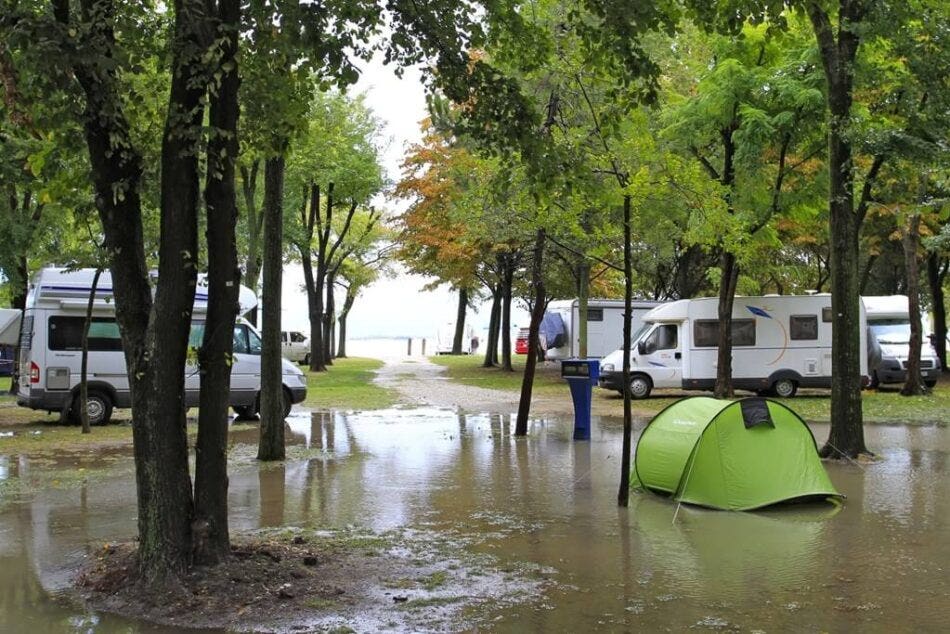Apart from your house and car your RV is probably one of the biggest purchases you’ve made or will make. With new RVs costing anything from $10,000 to $3 million that’s a big investment you want to protect. But an RV is also your “home away from home” and a major part of your leisure time and summer vacation. Doing what you can to protect your RV from storm damage is a no-brainer.
RV’s are constructed to be lightweight but also durable enough to withstand the elements. However extreme storms can be especially dangerous. Ideally you would store your RV inside a sturdy structure like a garage when seriously inclement weather is expected. Obviously that’s not an option for many and it’s definitely not available when you’re on the road. But you can take several steps to help shield your RV.
Protect Your RV from Storm Damage: The Roof
The roof of an RV is made either out of a type of plastic (called EPDM or TPO) or it is made out of fibreglass and aluminum. These materials do a pretty good job of protecting your RV in most normal weather conditions but everything has its limitations. The major issue on the top of an RV is the seams. The seams of an RV are held together by flexible sealants which allow the structure of the vehicle to be flexible and easily transported. However the sealants will eventually age and become brittle limiting the flexibility and sturdiness of the RV and making it more susceptible to damage when there is a storm.
The easiest way to protect your RV roof and ensure it can withstand a storm is to keep the seams in top condition. Get a cover to protect it from UV rays and moisture from rain and snow. This helps protect your seams and in the case that they are brittle or even fail a cover can help prevent your RV from sustaining damage.
People tend to think that when it comes to covering your RV roof it’s just a tossup between a tarp or an RV cover you choose which one you like better. However while tarps are easy to come by and are relatively cheap they can actually do more harm than good. They really hold onto heat and moisture. This warm environment is the perfect place for mold and mildew to form which defeats the purpose of the tarp – it is after all supposed to protect the roof not draw mold and mildew to it. Additionally the material that tarps are made of is actually very abrasive to the surfaces of your RV and the metal grommets rub on the surfaces during windy weather. Tarps have been known to grind down corners and edges of the roof which obviously causes a lot of damage to the RV itself. Plus tarps provide zero UV protection.
A good-quality RV cover on the other hand is lightweight and made to be flexible during inclement weather. They usually are rip resistant and allow moisture to escape from underneath the cover so mold and mildew do not form on the roof. They also are easy to put on and have special fasteners to keep the cover secure without damaging the sides of your RV.
Protect Your RV From Storm Damage: The Sides
While roof covers are great they only cover one thing – the roof. This leaves the sides of the RV at the mercy of the elements mainly wind and water/moisture. Damage done to the sides is the most noticeable since it is at eye level. There are products specifically designed to help maintain the exterior of your RV and many of them work by inhibiting the effects of UV rays.
Another prevention measure is to do a regular inspection. Make sure seals are air-tight windows and vents shut properly and that there are no cracks in the lining. If there are any issues get them repaired before they cause a serious issue.
Protect Your RV from Storm Damage: Your Campsite or On the Road
Many people value a heavily-treed campsite due to the sun protection and privacy. During a storm these trees can help or cause more harm – it depends. Do check for dead branches as these can easily be blown off in high winds and cause damage to your RV or vehicle.
Ensure you put away or secure any loose items. If you fail to do this these can be tossed around and cause damage. Don’t forget to collapse your awnings! You should do this every time you leave the trailer as storms can come out of nowhere and are extremely damaging to awnings.
It’s also best to collapse any soft tops as these are more vulnerable to wind and moisture damage.
The bottom line is this: an ounce of prevention is better than a pound of cure. Stay aware of local weather invest in a high-quality RV cover and keep your RV in good shape at all times. Once you’ve done these you can only wait for the storm to pass. Remember to stay safe yourself and invest in an RV policy to ensure you’re covered for storm damage.

